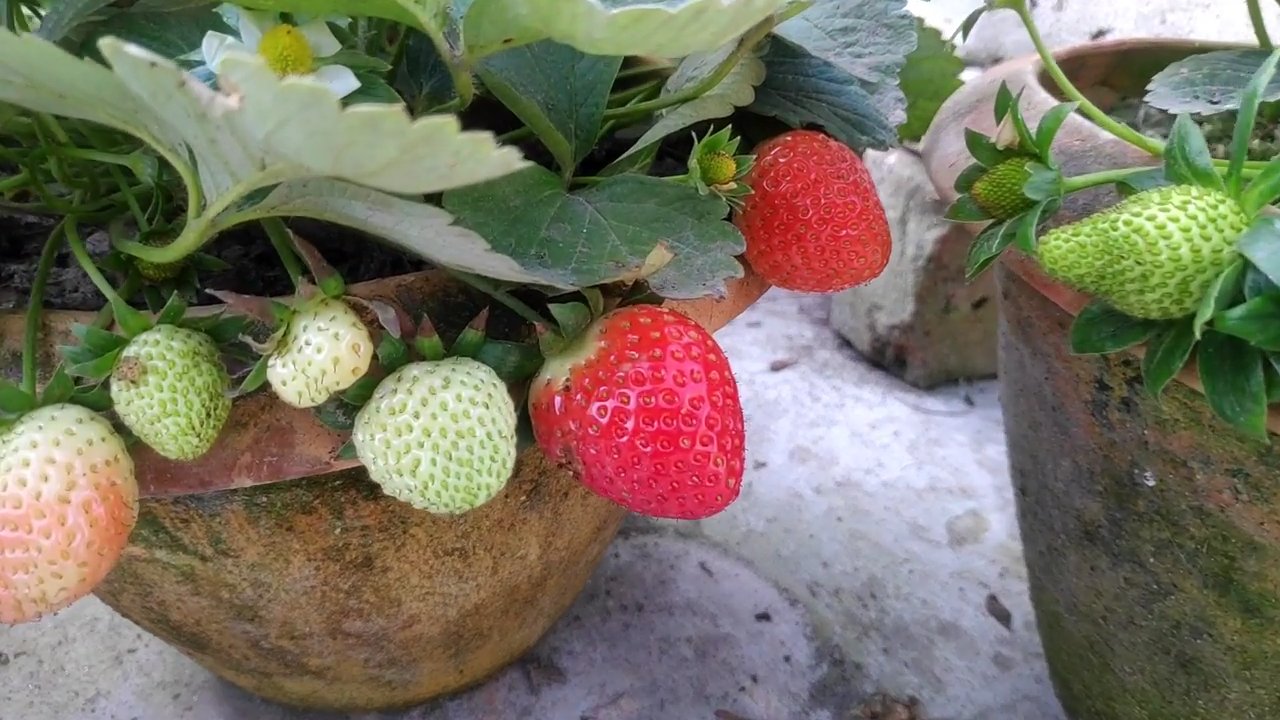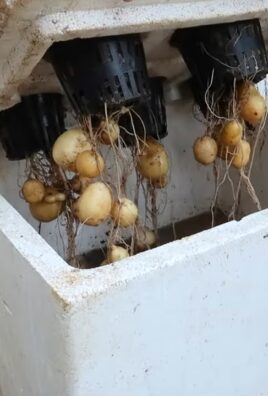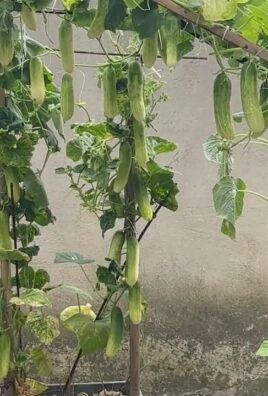Growing Strawberries Indoors might seem like a far-fetched dream, especially if you don’t have a sprawling garden. But guess what? It’s totally achievable, and I’m here to show you how! Forget those bland, store-bought berries – imagine plucking juicy, sun-kissed (well, grow-light-kissed!) strawberries right from your own home.
The allure of fresh strawberries has captivated people for centuries. From ancient Roman gardens to the strawberry fields of California, these little red gems have always been a symbol of summer and sweet indulgence. But you don’t need a vast estate or perfect weather to enjoy them.
In today’s world, where access to fresh, healthy produce can be a challenge, growing strawberries indoors offers a fantastic solution. It allows you to control the growing environment, ensuring optimal conditions for your plants, regardless of the season or your location. Plus, it’s incredibly rewarding to nurture something from a tiny seedling to a fruit-bearing plant. This DIY guide will provide you with simple, effective tricks and hacks to transform any space into a thriving indoor strawberry patch. Get ready to enjoy the taste of summer all year round!

Growing Strawberries Indoors: Your DIY Guide for a Sweet Harvest
Hey garden friends! Are you tired of expensive, tasteless strawberries from the supermarket? Me too! That’s why today I’m showing you how to easily grow your own juicy strawberries right inside your home. Sound crazy? It’s not! With a little love and the right tricks, you can enjoy a sweet harvest all year round. Let’s get started!
What you need: The Shopping List
Before we begin, here’s a list of everything you’ll need for your indoor strawberry paradise:
- Strawberry plants: Everbearing varieties are best, as they bear fruit multiple times a year. Popular varieties include ‘Seascape,’ ‘Albion,’ or ‘Tristan.’ You can buy young plants at a garden center or online.
- Planters: Choose pots with good drainage. Hanging baskets, regular pots, or even vertical planting systems are possible. The size should be at least 15 cm (6 inches) in diameter.
- High-quality potting soil: Use a well-draining potting soil that is rich in organic matter. Special strawberry soil is ideal, but regular potting soil mixed with some compost also works well.
- Grow light: Strawberries need a lot of light, especially in winter. A full-spectrum LED grow light is the best choice.
- Fertilizer: A liquid strawberry fertilizer is perfect for providing your plants with the necessary nutrients.
- Spray bottle: For moistening the leaves.
- Watering can: For watering the plants.
- Scissors or garden shears: For removing dead leaves and runners.
- Optional: Mulch (e.g., straw or coconut fibers) for moisture retention and weed suppression.
- Optional: A small paintbrush for pollinating the flowers (if no insects are present).
Step-by-Step Guide: Your Indoor Strawberry Garden Takes Shape
Now let’s get down to it! Follow these steps to successfully grow your strawberries indoors:
1. The Preparation:
- Clean your planters thoroughly.
- Fill the pots with potting soil, but leave about 2-3 cm (1 inch) of space at the top.
- Lightly moisten the soil. It should be damp, but not wet.
2. Planting:
- Carefully remove the strawberry plants from their nursery pots.
- Gently loosen the roots so they can spread out better in the new pot.
- Place the plants in the prepared pots. The top of the root ball should be level with the soil surface.
- Fill the pots with soil and press down lightly.
- Water the plants gently.
3. The Location:
- Place the pots in a bright location. A south-facing window is ideal, but east or west-facing windows can also work.
- If you don’t have enough natural light, use a grow light. Position the lamp about 30-60 cm (12-24 inches) above the plants and leave it on for 12-14 hours a day.
4. Care:
- Watering: Water the strawberries regularly, but avoid waterlogging. The soil should always be slightly moist. Check the moisture by sticking your finger about 2 cm (1 inch) deep into the soil.
- Humidity: Strawberries like high humidity. Spray the leaves regularly with water, especially when the air is dry. You can also place a tray of water near the plants.
- Fertilizing: Fertilize the strawberries every 2-4 weeks with a liquid strawberry fertilizer. Follow the instructions on the packaging.
- Pollination: Strawberries are self-fertile, but pollination by insects or wind can improve the harvest. If you don’t have insects indoors, you can pollinate the flowers with a small paintbrush. Simply brush gently over the flowers to distribute the pollen.
- Removing runners: Strawberry plants produce runners, on which new plants grow. These runners draw energy from the mother plant. Remove them regularly to encourage fruit production.
- Removing dead leaves: Regularly remove dead or yellow leaves to prevent diseases.
Special Tips for a Bountiful Harvest
Here are a few more tips that will help you maximize your strawberry harvest:
- Choose the right variety: As mentioned, everbearing varieties are best for indoor growing. They produce fruit over a longer period.
- Regular repotting: Repot your strawberries into larger pots every 1-2 years to give them more room to grow.
- Protection from pests: Watch out for pests like spider mites or aphids. If infested, you can use natural pesticides, such as neem oil or a soap solution.
- Be patient: It can take several weeks for your strawberries to bear fruit. Be patient and take good care of your plants, and you will soon be rewarded with a sweet harvest.
Challenges and Solutions
Challenges can also arise with indoor strawberry cultivation. Here are some common problems and how you can solve them:
- Yellow leaves: Yellow leaves can be a sign of overwatering, nutrient deficiency, or lack of light. Check your watering habits, fertilize the plants, and make sure they get enough light.
- No fruit: If your strawberries are not producing fruit, it could be due to a lack of pollination, too little light, or a nutrient deficiency. Pollinate the flowers manually, ensure sufficient light, and fertilize the plants regularly.
- Mold: Mold can occur if the humidity is too high and air circulation is poor. Ensure good ventilation and don’t spray the leaves too often.
Harvest Time!
The time has finally come! The strawberries are red and smell wonderful. Now you can harvest them!
- When to harvest? Harvest the strawberries when they are completely red and soft. They should detach easily from the stem.
- How to harvest? Cut the strawberries with scissors or garden shears to avoid damaging the plant.
- How to store? Fresh strawberries are best when eaten immediately. However, you can also store them for a few days in the refrigerator.
Enjoy!
Now comes the best part: Enjoying your homegrown strawberries! Whether on their own, in yogurt, in a cake, or as jam—your creativity knows no bounds.
I hope this guide has helped you start your own indoor strawberry garden. Have fun gardening, and enjoy your delicious treats

Conclusion
So, there you have it! Growing strawberries indoors isn’t just a whimsical dream; it’s a tangible reality within your reach. We’ve walked you through the essential steps, from selecting the right variety and providing optimal lighting to ensuring proper pollination and consistent watering. But why should you embark on this berry-filled adventure?
First and foremost, imagine the sheer delight of plucking fresh, juicy strawberries from your own indoor garden, regardless of the season. No more relying on supermarket berries that may lack flavor or have traveled long distances. You’ll have complete control over the growing process, ensuring the highest quality and the most delicious taste.
Beyond the immediate gratification of fresh strawberries, this DIY project offers a wealth of benefits. It’s a fantastic way to connect with nature, even within the confines of your home. Gardening is known to reduce stress, improve mood, and provide a sense of accomplishment. Plus, it’s an educational experience for children, teaching them about plant life cycles and the importance of sustainable food practices.
But the beauty of growing strawberries indoors lies in its adaptability. Feel free to experiment with different strawberry varieties to discover your personal favorites. Everbearing varieties, like Albion or Seascape, are particularly well-suited for indoor growing, as they produce fruit throughout the year. You can also explore different growing mediums, such as coco coir or hydroponics, to optimize your yields.
Consider adding companion plants to your strawberry pots to enhance their growth and deter pests. Basil, thyme, and marigolds are excellent choices that can create a thriving ecosystem within your indoor garden. You can also get creative with your containers, using hanging baskets, vertical planters, or even repurposed materials to add a touch of personality to your setup.
Don’t be afraid to tweak the techniques we’ve discussed to suit your specific environment and preferences. The key is to observe your plants closely, pay attention to their needs, and adjust your approach accordingly. Remember, gardening is a learning process, and every mistake is an opportunity to grow (pun intended!).
We understand that the prospect of growing strawberries indoors might seem daunting at first, but we assure you that it’s a rewarding and achievable endeavor. With a little patience, dedication, and the right information, you can transform your home into a miniature strawberry farm.
So, what are you waiting for? Grab your seeds or starter plants, gather your supplies, and embark on this exciting journey. We’re confident that you’ll be amazed by the results. And most importantly, don’t forget to share your experiences with us! We’d love to hear about your successes, challenges, and any unique tips or tricks you discover along the way. Share your photos and stories on social media using #IndoorStrawberries and let’s create a community of indoor strawberry enthusiasts. Let’s all learn how to best grow strawberries indoors!
Frequently Asked Questions (FAQ)
1. What are the best strawberry varieties to grow indoors?
Everbearing varieties are generally recommended for indoor growing because they produce fruit continuously throughout the growing season. Some popular choices include Albion, Seascape, and Tristar. These varieties are known for their compact size, disease resistance, and delicious flavor. Day-neutral varieties are also a good option, as they are not affected by day length and will produce fruit regardless of the amount of sunlight they receive. However, it’s essential to research the specific needs of each variety to ensure optimal growth and fruit production. Consider your local climate and the amount of available light when making your selection.
2. How much light do indoor strawberries need?
Strawberries require a significant amount of light to thrive and produce fruit. Ideally, they need at least 6-8 hours of direct sunlight per day. If you don’t have access to a sunny window, you’ll need to supplement with artificial lighting. LED grow lights are an excellent option, as they are energy-efficient and provide the full spectrum of light that plants need. Position the grow lights close to the plants, but not so close that they burn the leaves. Adjust the height of the lights as the plants grow to ensure they receive adequate illumination. A timer can be used to automate the lighting schedule, ensuring consistent light exposure.
3. How often should I water my indoor strawberry plants?
Watering frequency depends on several factors, including the type of growing medium, the size of the container, and the ambient temperature. As a general rule, water your strawberry plants when the top inch of soil feels dry to the touch. Avoid overwatering, as this can lead to root rot. Ensure that the container has adequate drainage to prevent water from pooling at the bottom. During the growing season, you may need to water more frequently, especially during hot weather. Check the soil moisture regularly and adjust your watering schedule accordingly. Consider using a moisture meter to accurately assess the soil’s moisture level.
4. How do I pollinate my indoor strawberry plants?
Indoor strawberries require pollination to produce fruit. Since there are no bees or other pollinators indoors, you’ll need to hand-pollinate your plants. This can be done using a small paintbrush or cotton swab. Gently brush the pollen from the stamen (the male part of the flower) to the pistil (the female part of the flower). Repeat this process for each flower. You can also use a small fan to circulate air around the plants, which can help to distribute the pollen. Pollinate your plants every day or two to ensure successful fruit set.
5. What kind of fertilizer should I use for indoor strawberries?
Strawberries are heavy feeders and require regular fertilization to produce abundant fruit. Use a balanced fertilizer that is specifically formulated for strawberries or other fruiting plants. Look for a fertilizer with an NPK ratio of around 10-10-10 or 12-12-12. Apply the fertilizer according to the manufacturer’s instructions. Avoid over-fertilizing, as this can burn the roots and damage the plants. You can also supplement with organic fertilizers, such as compost tea or fish emulsion. Fertilize your plants every 2-4 weeks during the growing season.
6. How do I deal with pests and diseases on my indoor strawberry plants?
Indoor strawberry plants are less susceptible to pests and diseases than outdoor plants, but they can still be affected. Common pests include aphids, spider mites, and whiteflies. These pests can be controlled with insecticidal soap or neem oil. Diseases such as powdery mildew and gray mold can also affect strawberry plants. These diseases can be prevented by providing good air circulation and avoiding overwatering. If you notice any signs of pests or diseases, treat them promptly to prevent them from spreading. Consider using organic pest control methods to minimize the use of harmful chemicals.
7. How long does it take for indoor strawberries to produce fruit?
The time it takes for indoor strawberries to produce fruit depends on the variety, the growing conditions, and the age of the plants. Generally, it takes about 4-6 weeks from flowering to fruit ripening. Everbearing varieties will produce fruit continuously throughout the growing season, while other varieties may only produce fruit once or twice a year. Be patient and provide your plants with the optimal conditions for growth and fruit production.
8. Can I grow strawberries indoors year-round?
Yes, you can grow strawberries indoors year-round, especially with everbearing or day-neutral varieties. To ensure continuous fruit production, you’ll need to provide your plants with adequate light, water, and nutrients. You may also need to adjust the temperature and humidity to create a favorable growing environment. With proper care, you can enjoy fresh strawberries from your indoor garden all year long.
9. What size pot should I use for growing strawberries indoors?
A pot that is at least 6-8 inches in diameter is recommended for growing a single strawberry plant indoors. Larger pots are preferable, as they provide more room for the roots to grow and allow for better drainage. You can also use hanging baskets or vertical planters to grow strawberries indoors. Ensure that the container has drainage holes to prevent water from pooling at the bottom.
10. How do I overwinter my indoor strawberry plants?
If you live in a cold climate, you’ll need to overwinter your indoor strawberry plants to protect them from frost. Move the plants to a cool, dark location, such as a basement or garage. Reduce watering and fertilization during the winter months. In the spring, gradually acclimate the plants to warmer temperatures and brighter light. Prune away any dead or damaged foliage. Once the weather warms up, you can move the plants back outdoors or continue growing them indoors.





Leave a Comment